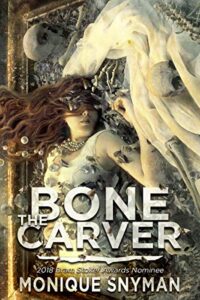The Bone Carver (The Night Weaver, Book 2) by Monique Snyman
Vesuvian Press, 2020
ISBN-13 : 978-1645480082
Available: Paperback, Kindle edition ( Bookshop.org | Amazon.com )
The Bone Carver is the sequel to The Night Weaver, a previous Stoker nominee in the YA category. These two factors mean it has a high bar to jump, as the second book in a series usually isn’t able to stand alone.
In The Night Weaver, seventeen-year old Rachel Cleary lives in the isolated New England community of Shadow Grove. She discovers her neighbor across the street, Mrs. Crenshaw, is a guardian protecting the boundary between our world and the fae realm in Shadow Grove. While out with Rachel, Mrs. Crenshaw’s visiting grandson, Dougal, recognizes the Black Annis, a fae creature who feeds on children. With the help of her former boyfriend, Greg, and Dougal, Rachel realizes there is a pattern of children’s disappearances over time that has been covered up by the town council and the sheriff. Complicating this mess is the involvement of a Orion, a drug-dealing fairy prince who has a strange connection with Rachel. She defeats the Night Weaver and saves the children.
The Bone Carver continues Rachel’s story. Reasonably wanting to escape Shadow Grove and go to college, Rachel has studied hard, but unfortunately she has a panic attack during her SATs. Dougal is now enrolled in school with her, Greg is attempting to make her jealous, Orion has returned to the fae realm, and a creepy new boy, Cam, is following her around. Entering an abandoned part of her high school, she discovers popular girl Mercia, who has epilepsy, having a seizure, and helps her recover. After the seizure is over, Rachel finds a bone carving of Mercia having a seizure. Later that day, after Mrs. Crenshaw falls and breaks her hip, Rachel finds another bone carving. Rachel is convinced a “miser fae” called the Bone Carver is causing the accidents. As more people find disturbing bone carvings of themselves, Rachel and Dougal investigate, and find gory evidence of powerful fae magic. They determine that Rachel needs to enter the fae realm to find Orion.
Mercia reveals that she is a witch able to open a dimensional portal to the fae realm, and Rachel goes through, wanders aimlessly, causes a disaster, is kidnapped by Orion’s older brother Nova, the king of the fairies, and finally leaves with Orion to (hopefully) save the day. During her five days in fairyland, things have gotten exponentially worse, with people, including her mother, ending up in the hospital or acting violent or irrational, and the high school in a shambles. Despite her recent desire to flee Shadow Grove, Rachel decides she is willing to die to take the Bone Carver down and save the town.
The Bone Carver is suitably chilling and gruesome and doesn’t stint on body horror. Snyman has a talent for vivid description, as evidenced by Rachel’s visions of the vicious deaths the Bone Carver has inflicted on the girls he’s murdered. The plot around Jenny, Rachel’s mother, was extremely disturbing. There’s a heavy #MeToo, anti-incel message to the book as well, and the scenes between Rachel and Greg, Rachel and Cam, and Rachel and the Bone Carver thoroughly creeped me out.
However, what most impressed me, was the author’s depiction of Mercia. She is a well-developed character: competent, smart, caring, attractive, and popular, and when Greg gets irrational and handsy with Rachel, Mercia has no problem knocking him out. It’s easy to write a character who is living with epilepsy as an invalid or pitiful and in need of rescue, but Mercia is never written that way or treated like one by other characters. Although she comes from a family of witches (and it irritated me that her epilepsy was magically caused) she isn’t effortlessly “magical”, and she isn’t suddenly “cured” at the end of the story. In fact, her seizures aren’t quite under control, and she needs medication to help. As someone living with epilepsy I can tell you that this is a character type I have NEVER seen in any book depicting someone living with epilepsy in any age group or genre, and it was absolutely a pleasure to read this.
Unfortunately, Mercia is one of the few characters that actually did have character development and purpose in the book. Dougal and Mrs. Crenshaw are out of the picture for a majority of the book, Greg is essentially a plot device, and after all the to-do about going to the fae realm and bringing back Orion, I question whether he was useful enough to justify Rachel’s disappearing for five days while everything fell to pieces. There’s a huge reveal at the end of the book, so I assume he’ll be more involved in book three. While a nice addition to the series, though, The Bone Carver really cannot stand alone as a novel, and doesn’t hold together as well as the first book. For its depiction of a character living with epilepsy, however, I highly recommend it.
Contains: body horror, gore, violence, sexual assault, mentions of self-harm and suicide.
Reviewed by Kirsten Kowalewski
Editor’s note: The Bone Carver (Shadow Grove, Vol. #2) is a nominee on the final ballot for the Bram Stoker Award in the category of Superior Achievement in a Young Adult Novel.


 e who isn’t like them. Mary Shelley’s description of Frankenstein’s monster and his friendship with the little blind girl is a perfect example of how dependent we are on sight as a cue to decide who is a monster and who is not.
e who isn’t like them. Mary Shelley’s description of Frankenstein’s monster and his friendship with the little blind girl is a perfect example of how dependent we are on sight as a cue to decide who is a monster and who is not.








Follow Us!